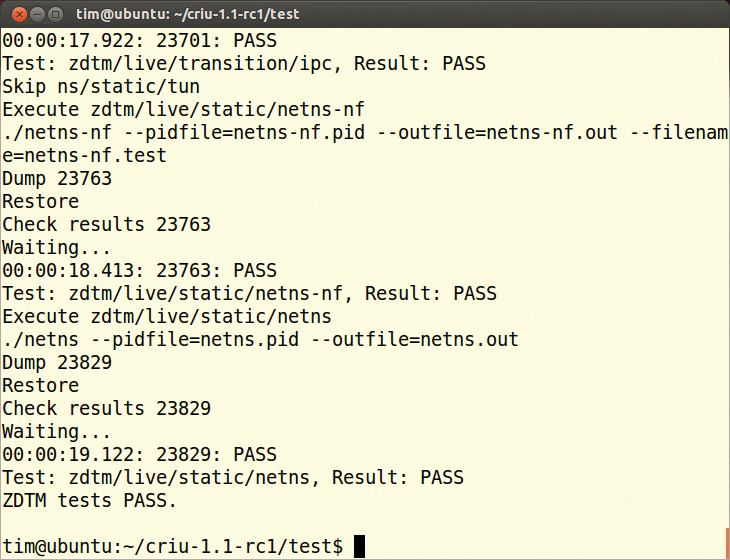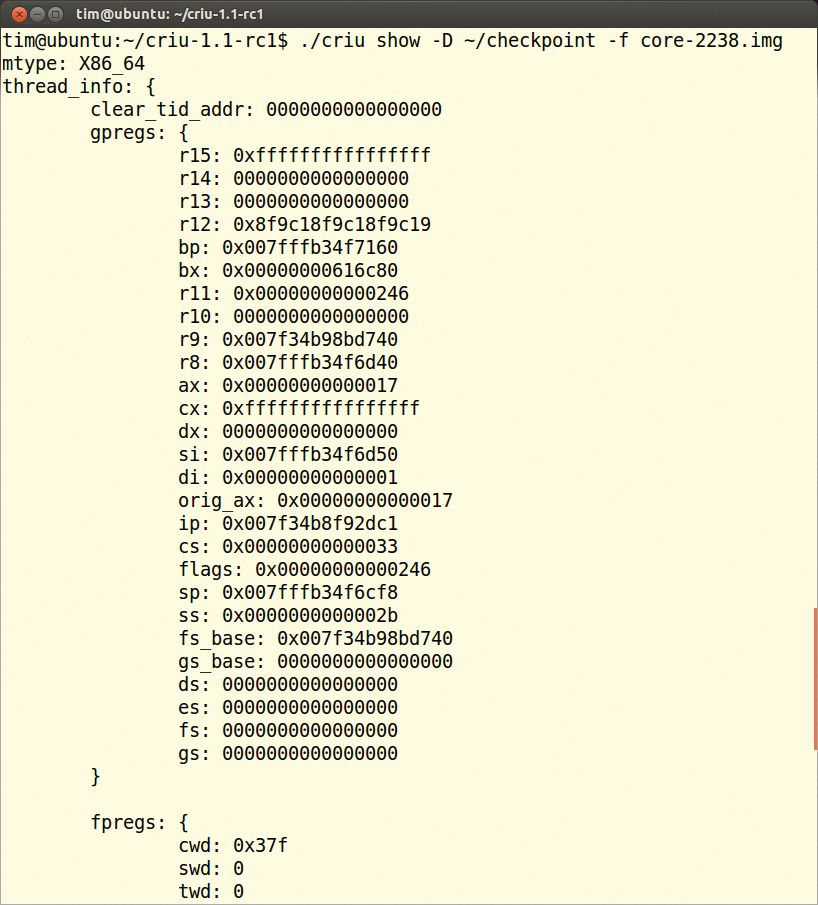
Save and restore Linux processes with CRIU
On Ice
Some maintenance work can only be done when no production software is running, but admins cannot terminate processes at will; otherwise, they risk losing data and time-consuming computations that will have to restart from scratch. The remedy on Linux systems is a small tool named "Checkpoint/Restore In Userspace," or CRIU.
CRIU freezes the current state of a process and saves it on the hard disk. Later, you can bring the process back to life; it then continues working at the point where CRIU froze it. For virtual machines, this is known as creating snapshots.
Freezing is not useful just to allow maintenance. Suspended processes can be moved to other computers and continue to run there. This live migration helps, for example, in load balancing scenarios: If a computer is just twiddling its thumbs, you can use a script to transfer a process to it. You can also freeze suspicious processes and analyze them on another system at your leisure. If you integrate CRIU in your system's startup scripts, it backs up processes automatically when you shut down and brings them back up on the next boot. In this way, you not only save the state before switching off but also shorten the boot process.
Numbers
Development is proceeding quickly. The first CRIU version appeared less than two years ago. When I first started writing this article, only the first release candidate of the 1.1 version was at available; v1.1-rc2 and v1.1 followed soon after. Two more versions followed quickly, and when this article went to press, v1.3-rc2 was the most recent release. The following comments are based on the v1.1 release candidate. Other versions are available in the release archive [1].
CRIU indeed works completely in userspace, but it imposes several requirements on the running system. First, the program only works on systems with ARM or x86_64 architecture; in the latter case, you must be running 64-bit Linux. Version 1.3-rc1 added AArch64. Furthermore, CRIU requires Linux kernel version 3.11 or greater. Current desktop distributions satisfy this condition, but popular Linux distributions on servers, Debian 7, and CentOS 6.5 do not. The use of CRIU on these systems thus would require a kernel upgrade.
The running kernel must also provide the information required by the CRIU functions. Table 1 lists the settings you need to enable when you compile the kernel. CRIU checks the kernel's compatibility with criu check.
Tabelle 1: Required Kernel Functions
|
Variables |
Enable in the Configuration Menu |
|---|---|
|
|
General setup | Embedded system |
|
|
General setup | Configure standard kernel features (expert users) |
|
|
General setup | Configure standard kernel features (expert users) | Enable eventfd() system call |
|
|
General setup | Configure standard kernel features (expert users) | Enable eventpoll support |
|
|
General setup | Checkpoint/restore support |
|
|
General setup | Namespaces support |
|
|
General setup | Namespaces support | PID Namespaces |
|
|
General setup | Open by fhandle syscalls |
|
|
File systems | Inotify support for userspace |
|
|
Executable file formats | Emulations | IA32 Emulation |
|
|
Networking support | Networking options | Unix domain sockets | UNIX: socket monitoring interface |
|
|
Networking support | Networking options | TCP/IP networking | INET: socket monitoring interface |
|
|
Networking support | Networking options | TCP/IP networking | INET: socket monitoring interface | UDP: socket monitoring interface |
|
|
Networking support | Networking options | Packet socket | Packet: sockets monitoring interface |
|
|
Networking support | Networking options | NETLINK: socket monitoring interface |
|
|
Processor type and features | Track memory changes |
Because of the detailed requirements for the operating system kernel, the CRIU developers previously provided a suitable kernel. Since kernel 3.11, however, Linux possesses all the features necessary, so the old CRIU kernel is no longer needed and no longer recommended.
If the kernel meets all the requirements, you also need Google's Protocol Buffers library [2] [3], which is available in the repositories of most distributions. Besides the library itself, you need the corresponding development packages, the C bindings and the Protobuf C compiler. On Ubuntu and Debian the appropriate packages go by the names libprotobuf-c0-dev and protobuf-c-compiler; look out for similar names on other distributions.
CRIU also relies on iproute2 – at least version 3.5.0 from August 2012. This tool is also on board with most recent distributions. If not, as is the case for Debian 7, you will find the source code online [4].
Test Run
To build CRIU, you need the sources [5], the Make tool, and a C compiler. After unpacking the archive and compiling with make, a system-wide installation of the tool is neither intended nor necessary.
Before you deep freeze the first processes, a CRIU test is recommended. To do this, run this command as the root user:
criu check --ms
When done, CRIU should output Looks good (see Figure 1). Otherwise, the tool tells you which function is missing. Older versions of the tool still went by the name of crtools. Therefore, some instructions still circulating on the Internet refer to this command name.

The next test step takes place in the CRIU test subdirectory. Call the zdtm.sh script as root to start a test suite that starts multiple processes and freezes them for test purposes. A complete cycle takes a few minutes, during which the system can freeze repeatedly. If a problem occurs, the test suite aborts and tells you the root cause. After a successful run, you will only see the results of the last test (Figure 2).

Sandman
To freeze a process after successful tests, CRIU requires only the process ID and location. The following command backs up the process with the PID of 2238 in the checkpoint subdirectory below the user's home folder:
criu dump --images-dir ~/checkpoint --tree 2238
The criu command is always followed by the action to be executed – in this case, it creates a backup, or dump image, if you prefer. --images-dir (or -D) is the directory and --tree (or -t) the process ID. CRIU requires root privileges for all actions.
Freezing fails, however, if the process to be stored shares resources with the parent or any other process. In this case, CRIU cancels the action just to be on the safe side. For processes started from a shell, such resource sharing often cannot be avoided. You have three options here: Move a process into the background, start it in a separate session, or pass CRIU the additional --shell-job parameter (Figure 3):

--shell-job parameter.criu dump -D ~/checkpoint -t 2238 --shell-job
In the target directory (e.g., ~/checkpoint) CRIU creates several files for a backed-up process. Each file contains the state of a resource used by the process (Figure 4). CRIU overwrites existing files without warning.

After the process is backed up, CRIU then terminates it. The latest output is sent to the terminal, unformatted as shown in Figure 5, if necessary. The CRIU --leave-running parameter ensures that CRIU can continue to run the stored process.

Reanimation
To wake up a stored process, use the command:
criu restore -D ~/checkpoint --restore-detached
The --restore-detached parameter ensures that CRIU terminates after the restore. The reanimated process then has init as its parent process and keeps the same process ID as before the freeze. If this PID has been reassigned in the meantime, the restore quits with an error. You can remedy this using the --namespaces or -n option, which means the task is assigned a new PID by the system and only retains its old ID internally in a virtual process namespace.
If you backed up the process using --shell-job, this same parameter is mandatory for the restore (Figure 6). The process then starts up in the shell in which you called criu. Under certain circumstances, it takes a moment for the process to actually start working.

--shell-job fails without stating the reason.When you restore, the backup remains in the checkpoint directory. You can thus revive the process in the same place at any time.
To wake up the stored process on another system, you copy the complete directory with the backup to the other computer and revive the process there with criu restore. However, the new environment must match the old one and contain the necessary files in the same directory paths. Ideally, the new system will be a clone. Another option is to use a distributed filesystem such as NFS to provide the files. In any case, administrators should run through live migrations for test purposes to find missing libraries, configuration files, and documents and put them in place.
Looking Ahead
CRIU lets you prepare a backup process then accelerate it with the pre-dump parameter:
criu pre-dump -t 2369 -D ~/checkpoint/pre
Processes continue to run normally after this step. A new call to the command at any time updates the backup (Figure 7) by pointing to the pre-dump with the --prev-images-dir parameter,

pre-dump speeds up the storage process.criu dump -t 2369 -D ~/checkpoint/dump --prev-images-dir ../pre
which expects a path relative to the directory specified by -D. In the example above, the pre-dump output ends up in ~/checkpoint/pre, with the dump in ~/checkpoint/dump. Restoring with
criu restore -D ~/checkpoint/dump --restore-detached
works like any other restore command.
Thrifty Repetition
If you want create multiple snapshots for a process, you can save time and storage space with an incremental backup. To do this, first create a dump as usual, but leave the process running with the --leave-running parameter:
criu dump -t 2334 -D ~/checkpoint/1/ --leave-running --track-mem
The first backup ends up in the ~/checkpoint/1/ directory. Thanks to the --track-mem parameter, CRIU can tell the kernel to watch the main memory area of the process. A second dump accelerates its information:
criu dump -t 2334 -D ~/checkpoint/2/ --leave-running --track-mem \ --prev-images-dir ../1/
In this example, --prev-images-dir reveals the location of the first backup, again creating the directory relative to the path defined by -D. Following the same principle, you then create additional backups. For the last dump, abandoning the --leave-running and --track-mem parameters terminates the process. The subsequent recovery is the same as before:
criu restore -D ~/checkpoint/2/ --restore-detached
A directory normally contains a complete backup. On request, CRIU saves space by storing only the changes that happened since the last dump. This is the task of the deduplication feature, which you call with the --auto-dedup parameter:
criu dump -t 2334 -D ~/checkpoint/2/ --leave-running --track-mem \ --prev-images-dir ../1/ --auto-dedup
CRIU will now delete all unnecessary data in the previous backup, but not in the new one, so you now have a complete dump in ~/checkpoint/2; ~/checkpoint/1 only keeps the delta to the second backup. If you already have incremental backups, the dedup action,
criu dedup -D ~/checkpoint/2/
retroactively reduces them to the delta.
Pitfalls
"Freezing and thawing" does not work for some processes. The CRIU developers offer a short list of officially supported software [6]; it includes programs such as Make. GCC, Tar, Git, Apache, MySQL, SSH, and MongoDB. You can never freeze processes that are accessing a hardware device – whether block or character – for two reasons: The precise functions of the device are hidden from CRIU, and when restoring a process, the device could be missing.
Because CRIU uses the same interfaces as a debugger, the tool cannot freeze any processes that are already being monitored by Strace or GDB.Also, CRIU does not back up processes that hold file locks, because CRIU cannot determine whether another process is allowed access to the file in question. However, the optional --file-locks parameter forces CRIU to back up the lock, too. Furthermore, version 1.1 of CRIU cannot cope with the Btrfs filesystem, although the developers are working on a solution.
Additionally, some values can change after restoring a process, including the IDs of mountpoints, sockets, and the process start time; cat /proc/1234/stat (e.g., for a process with an ID of 1234 in field 22) unveils the start time.
On the Network
CRIU freezes programs that communicate over a TCP connection with the help of the Linux kernel. To do so, it closes the socket and blocks the TCP connection with additional firewall rules. CRIU thus ensures that the connection remains in the same state when saved. Therefore, this firewall rule must still be in the Netfilter table when you restore the process.
To trigger the use of a TCP connection, you pass CRIU the --tcp-established parameter for the backup and restore. Such a process can only be frozen and restored exactly once. Any further attempt will fail, because the TCP connection then has a different state. The CRIU wiki describes the technical background in detail [7].
CRIU not only freezes the process, but for safety's sake, its child processes and any dependent processes, as well. If two programs talk through a pipe or a Unix socket, CRIU therefore needs to freeze both simultaneously.
In some situations, however, CRIU can only freeze one of the two processes; in this case, CRIU refuses to continue and outputs an external socket is used error message. Using the --ext-unix-sk parameter for the backup and restore, you can still persuade CRIU at least to back up a process. When restoring, however, you must then ensure that the remote site already exists.
Conclusions
CRIU provides extremely useful functionality, and many fixes have been made since the version used in this article [8], but caution is advised in production use. Extensive pretesting with the proposed setup is therefore an essential requirement. CRIU development is progressing at a rapid pace, and anyone who wants to freeze and migrate processes should keep CRIU in mind (see also the "Remote Control" box). Further information, including insight into CRIU techniques, is provided by the extensive wiki [5].
